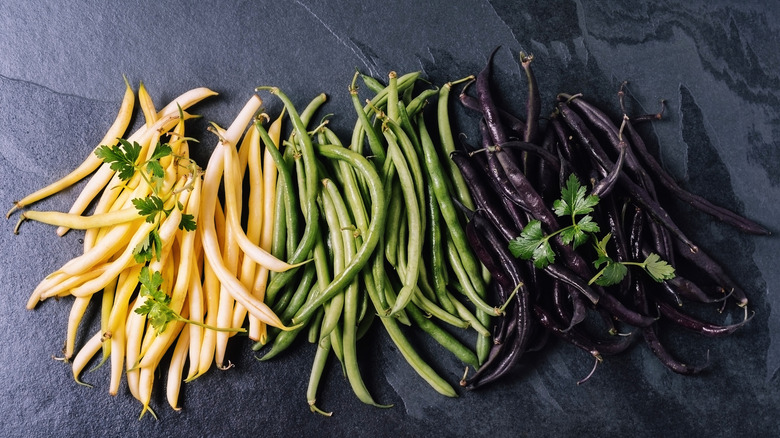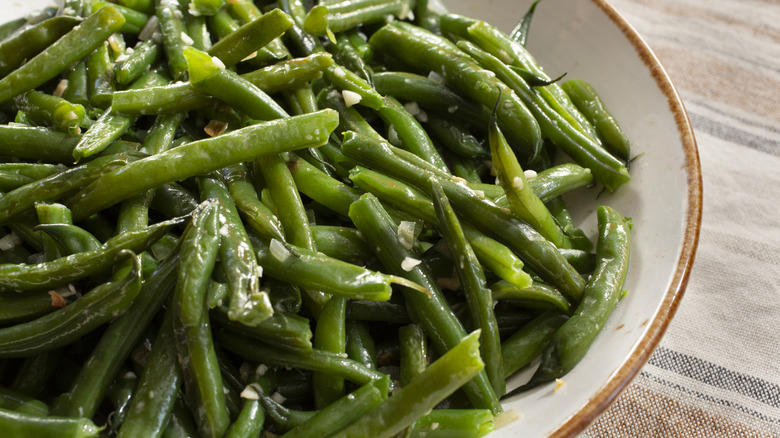Haricot Verts Vs Green Beans: What's The Difference
When you think of green beans your mind might wander to plates of vegetables your mom forced you to eat as a kid. They make a dinner plate look and feel kind of blah but add a serving of haricot verts to your plate, and everyone starts feeling a little fancy. Perhaps you've ordered haricot vert in an upscale restaurant thinking you will be wowed by something bougie and unexpected, only to be seriously let down when you get your plate of steak and frites, with a side of string beans. Aside from two very different sounding names, these two vegetables don't really look that different, so what actually sets them apart?
The answer is a bit nuanced. In other words, they are the same but different. The term "Green bean" refers to a number of varieties of long, green pods that grow either in bush or pole varieties, and haricot vert actually means "green bean" in French (haricot meaning bean and vert meaning green). So, haricot verts are, simply put, green beans, but the differences extend well beyond the name. Haricot verts are actually a specific variety of green beans, one that is more common in France and is often referred to as a French green bean, while the green beans commonly found in American grocery stores (both in the produce section and in cans) are a variety known as the blue lake bean.
They will both make a fantastic addition to any meal, from a Thanksgiving feast or a night out at a steakhouse to a simple side dish on a weeknight after a long day at work, but there are differences in size, taste, and appearance, so to truly appreciate the beans on your plate, it's worth exploring the differences between the haricot verts and common green beans.
Give your haricot verts the treatment they deserve
Haricot verts are the more delicate of the two varieties, and not just in their pronunciation. (To pronounce haricot verts properly, simply drop the 'h' and both 't's: aree-koh vers.) They are typically picked early in the season when the beans are still young and, as a result, you get nice tender beans that are full of flavor and don't require a lot of cooking. They are often harvested in the summertime, when they are at their peak, and the flavor is often more robust than a regular green bean.
Much like premium ice cream is definitely not the same as regular ice cream, haricot verts deserve recognition for their delicate nature and shouldn't be compared to more common green bean varieties. They are longer, thinner, and daintier than other types of green beans, and as such, they get special attention. They are often described as "fresher" than other varieties, making them an ideal side dish for a special meal. To serve them, you can sauté them, roast them, or even steam them, but you don't need to add a lot of extra ingredients to elevate the flavor — a dab of olive oil, salt, and garlic will do. Their delicate nature speaks for itself.
They may not be fancy, but green beans are anything but basic
Blue lake beans, usually simply referred to as green beans, are generally a much hardier bean than the fancier haricot verts variety. They are shorter, thicker, and need to grow to maturity to be tender and achieve their best flavor, so if you are hoping to trick your palate with picking them early to pass them off as haricot verts, you'll be out of luck and wind up with tough, tasteless beans. These beans are the most common type used for freezing and canning and are used in everything from casseroles to the pickled variety you find on salad bars.
While not as fancy as their French cousins, the common blue lake green beans are anything but basic and have plenty of use in the culinary world. Of course, you can always give them a quick steam and serve them as a simple yet nutritious side dish for a quick and easy weeknight dinner or you can add some flair and serve them in bundles tied with a caramelized bacon sash. They can also take center stage if you use them as a main component in a salad with something creative and upscale like a green bean and tomato panzanella salad, you won't be disappointed as long as you aren't hoping to pass them off for haricot verts.


